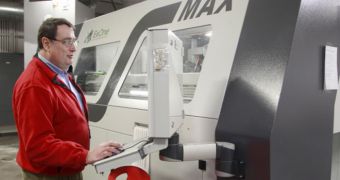Most 3D printers we've covered are the sort that fit on a desk, or inside a room, but there are models that far exceed them in size, and one of them has been helping university students to learn manufacturing, among other things. Said model is called S-Max and is a positively massive piece of work, as large as a van, if not larger. And students from the University of Iowa have full access to it.
Well, those whose passion lies in manufacturing and engineering anyway. Metal Casting Center Director Jerry Thiel had to spend two years convincing the Iowa Department of Economic Development to pay $1.2 million / €890,000 of the price ($1.5 million / €1.1 million) for it.
S-Max uses many specially engineered sand varieties which get mixed with a resin binding agent. From that material, it can make objects as large as 6 feet / 1.8 meters by 3 feet / 0.91 meters.
UNI has been making up the difference by selling use of the printer to private businesses, like John Deere and Honeywell Aerospace.
“The flexibility we have with this unit is amazing,” said Thiel. “We can do things that other people can’t.”
S-Max works like this: a robotic arm spreads a uniform layer of sand less than three grains deep, then a layer of resin is sprayed in the pattern of the object that is being created. Then another layer of sand is added, and things repeat from there.
3,000 pounds / 1,360 kilograms of moulds and objects can be made at the same time, which is a staggering amount any day. It takes around 45 minutes to complete an inch, and each layer measures 1/7000th of an inch.
The Metal Casting Center will get the S-Max once the price is paid in full, where an Advanced Manufacturing Center will be established.
In the meantime, students can use it for their projects. It's a little known fact that most new research is carried out by undergrads. A young technology like 3D printing can only benefit from being exposed to uncluttered minds that haven't fallen prey to reasoning routines yet.

 14 DAY TRIAL //
14 DAY TRIAL //